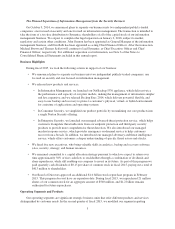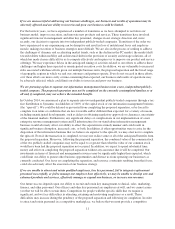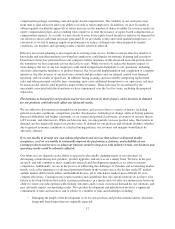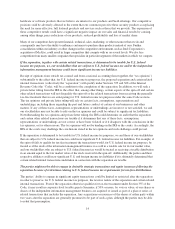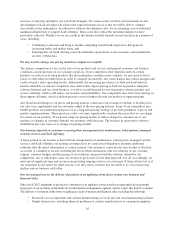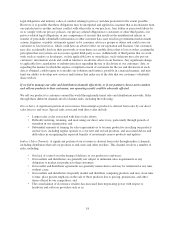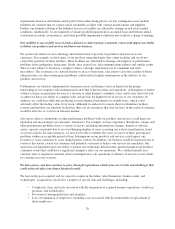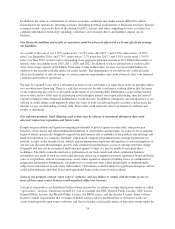Symantec 2015 Annual Report Download - page 93
Download and view the complete annual report
Please find page 93 of the 2015 Symantec annual report below. You can navigate through the pages in the report by either clicking on the pages listed below, or by using the keyword search tool below to find specific information within the annual report.To preserve the tax-free treatment to us of the separation, the parties will agree not to take or fail to take any
action that prevents the separation and related transactions from being tax-free, among other restrictions. These
restrictions may limit our ability to pursue strategic transactions.
Fluctuations in our quarterly financial results have affected the price of our common stock in the past and
could affect our stock price in the future.
Our quarterly financial results have fluctuated in the past and are likely to vary significantly in the future due to a
number of factors, many of which are outside of our control. If our quarterly financial results or our predictions
of future financial results fail to meet our expectations or the expectations of securities analysts and investors, our
stock price could be negatively affected. Any volatility in our quarterly financial results may make it more
difficult for us to raise capital in the future or pursue acquisitions that involve issuances of our stock. Our
operating results for prior periods may not be effective predictors of our future performance.
Factors associated with our industry, the operation of our business, and the markets for our products may cause
our quarterly financial results to fluctuate, including:
• Reduced demand for any of our products and services;
• Entry of new competition into our markets;
• Competitive pricing pressure for one or more of our classes of products;
• Our ability to timely complete the release of new or enhanced versions of our products;
• How well we execute our strategy and operating plans and the impact of changes in our business model
that could result in significant restructuring charges;
• Fluctuations in foreign currency exchange rates;
• The number, severity, and timing of threat outbreaks (e.g. worms and viruses);
• Our resellers making a substantial portion of their purchases near the end of each quarter;
• Enterprise customers’ tendency to negotiate site licenses near the end of each quarter;
• Cancellation, deferral, or limitation of orders by customers;
• Changes in the mix or type of products sold;
• Movements in interest rates;
• The rate of adoption of new product technologies and new releases of operating systems;
• Changes in accounting rules;
• Weakness or uncertainty in general economic or industry conditions in any of the multiple markets in
which we operate that could reduce customer demand and ability to pay for our products and services;
• Political and military instability, which could slow spending within our target markets, delay sales
cycles, and otherwise adversely affect our ability to generate revenues and operate effectively;
• Budgetary constraints of customers, which are influenced by corporate earnings and government
budget cycles and spending objectives;
• Disruptions in our business operations or target markets caused by, among other things, earthquakes,
floods, or other natural disasters affecting our headquarters located in Silicon Valley, California, an
area known for seismic activity, or our other locations worldwide;
• Acts of war or terrorism;
• Intentional disruptions by third parties; and
• Health or similar issues, such as a pandemic.
Any of the foregoing factors could cause the trading price of our common stock to fluctuate significantly.
Our business models present execution and competitive risks.
In recent years, our SaaS offerings have become increasingly critical in our business. Our competitors are rapidly
developing and deploying SaaS offerings for consumers and business customers. Pricing and delivery models are
evolving. Devices and form factors influence how users access services in the cloud. We are devoting significant
15


